The Cretaceous plant at the Hill Annex mine of the Jones & Laughlin Steel Corp. was designed with a wet autogenous mill for grinding low grade iron ore so that it could be concentrated by spirals and flotation cells. The plant, on the west end of the Minnesota’s Mesabi Range, went into operation in June 1961, and preliminary operating and metallurgical information describing the performance of this mill can now be given.
The crude is lean ore from the Cretaceous iron foundation. This formation is a beach deposit of Cretaceous age that overlies the Precambrian direct shipping and concentrating ores. This rock in nature is not extremely hard but is quite resilient, resisting blasting in mining and size reduction in milling. It contains hematite as water-rounded particles and other fragments of the underlying iron formation and adjacent rocks cemented together by a high alumina-silica ferruginous matrix.

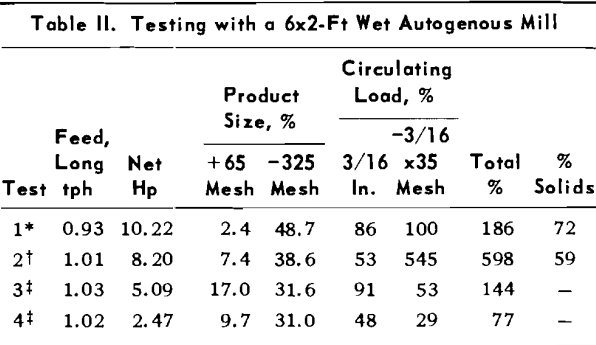
The power consumption is believed to have varied because of variation and composition of the crude. No grate blinding or accumulation of critical size material occurred during the tests, but since hard material was known to be present in the reserve, provision was made in the design of the commercial plant for its removal. A – 28 or 35 mesh product was ideal spiral feed, and a number of tests were run at this grind.
Actually the mill that was ordered has a nominal size of 22×7 ft and measures 21.3 ft inside of liners. It was manufactured by the Hardinge Co. who built a mill of this size for grinding Galena ore in Sweden, and it was to Jones & Laughlin’s advantage to duplicate this design, since the computed capacity approached that required. Specifications of the mill are given in Table III while Fig. 1 is a section showing feed chute, liners, grates and overall dimensions.
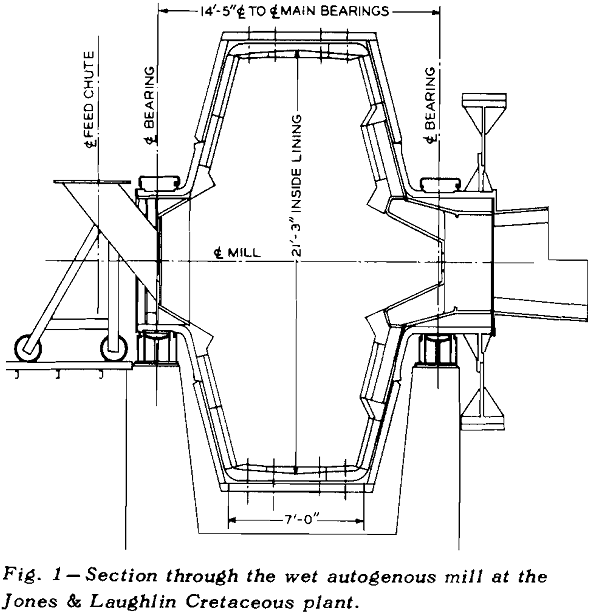
To initially seat the bearings the mill was operated for 72 hr without liners at approximately one third bearing load. Although the felt oil seals failed by gathering on the trunnion and bunching within the retainers, the bearings operated satisfactorily during the run which, incidentally, required 17 hp. The seals were replaced with double-lip neoprene type having a Y shape and the complete set of liners was installed which increased the bearing loads to 80% of normal. Shortly after run-in resumed, bearing temperatures rose higher than normal and fine streaks of aluminum formed on the trunnions.
The use of aluminum alloy bearings for this design and loading is not unusual. In a properly seated and designed application they give excellent service. They are, however, soft and scratch easily. Heat dissipation is not good, and any slight scratch that develops or high spot not receiving full lubrication overheats quickly, wiping bearing metal onto the trunnion and causing a failure.
The discharge grates presented an unexpected problem. There had been concern that decayed trestle timbers, ties and roots would blind the grates, but this did not occur. When this material enters the mill, it is ground to a pulp, but may partially blank the decks of the secondary screens. Instead the grates blinded almost completely with small, hard pebbles within a few hours. Pulp overflowed the feed inlet, and the mill was shut down to chisel the pebbles free.
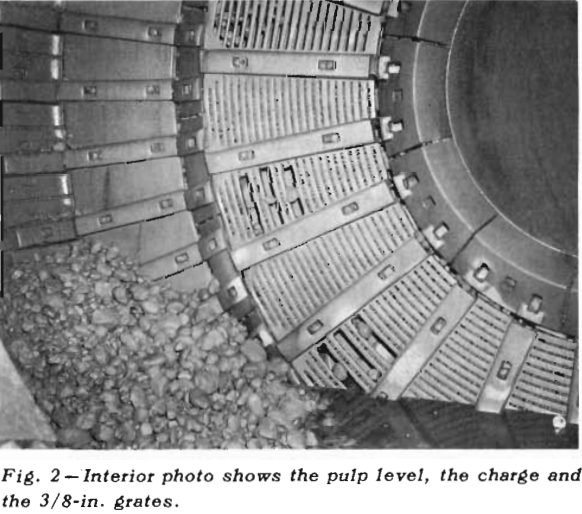
Examination of the charge reveals there are almost no large pebbles. Most approach 2 to 4-in. topsize and these apparently reduce slowly and largely by attrition, so that an accumulation of smaller pebbles develops. The operators feel provision should be included in the design of the grates to relieve the large pebbles, and they suggest grates be provided with ¾-in. slots arranged radially with occasional 2-in. concentric slots in some grates provided concentrically about the inner grate circle.
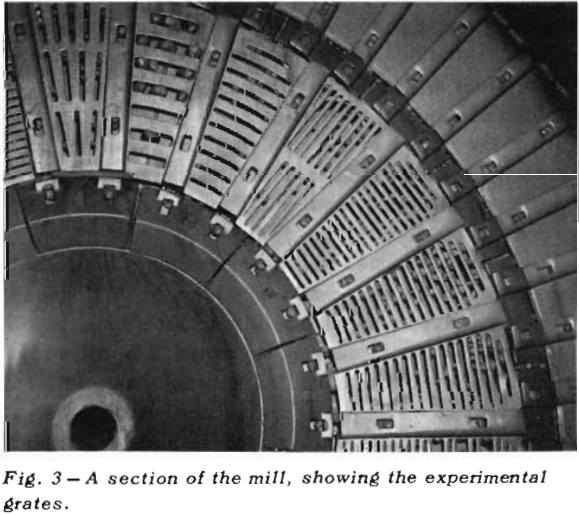
A plant incorporating a wet autogenous mill does not include some of the crude preparation stages that may be necessary in other flowsheets. Fig. 4, which is a detail of the Cretaceous plant flowsheet through the crushing and grinding sections illustrates this Crude is crushed to 8 in. and fed directly to the mill which is in closed circuit with primary and secondary screens. The primary screen separates at 3/16-in. The coarse product returns to the mill, while the fines are pumped to the secondary screens for 28 mesh separation. The coarse from these launders into the mill, and the undersize is pumped to cyclones for desliming and dewatering before distribution to the concentrating section.
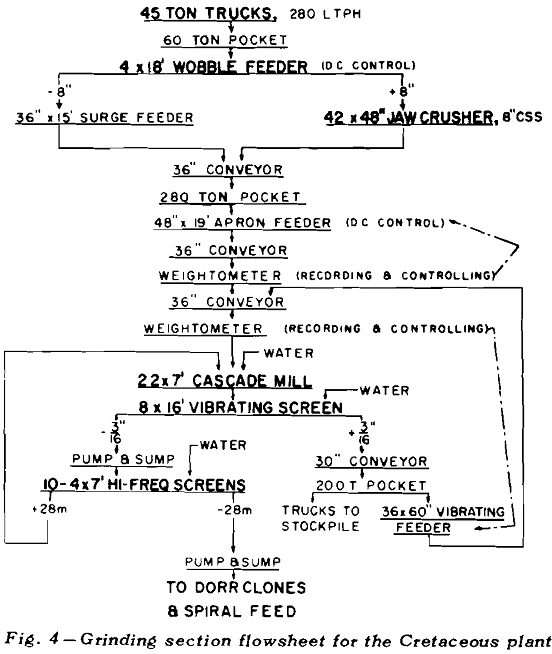
After production began, measurements of mill performance were taken and comparisons were made of product size, power consumption and capacity in the pilot and commercial operations. A number of screen analyses have been prepared of feed and product.
Power readings indicate that unit consumption this season has been substantially higher than the average recorded during pilot test work. This is of concern, since input may be reduced by motor limitation and since readings were taken when a portion of the coarse in the recirculating load was being withdrawn from the circuit and stockpiled.
During the first season 380,000 tons of crude were delivered to the mill. Although production demands limited test operations, considerable information was obtained relative to the mechanical and metallurgical performance of an autogenous mill
Wear on linings was not established conclusively. Prior to use of large diameter grinding balls, shell lifters appeared to have a million-ton life. However, during the four weeks balls were used, wear was extreme and they require reversal now.
The mill operates at the noise and vibration level of a ball mill and does not require a special foundation. An overhead crane to remove the mill cannot be justified, but a heavy structural cradle should be provided to permit raising it with jacks from both bearings simultaneously. Platforms should be arranged to service head and shell bolts and the bearings.

